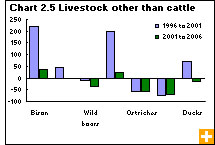Common menu bar links
Livestock’s leading edge
Archived Content
Information identified as archived is provided for reference, research or recordkeeping purposes. It is not subject to the Government of Canada Web Standards and has not been altered or updated since it was archived. Please contact us to request a format other than those available.
Sometimes farmers explore the leading edge of their business in search of profits. In the 1970s, grain farmers first tried canola; in the 1980s, livestock producers began to explore alternative species. It was a way for them to diversify, which can insulate them from risk, and to make use of marginal farmland.
Some of the species have found growing market niches, such as bison, llamas and alpacas and, to a lesser degree, goats. Other species have burst onto the scene, peaked and retreated.
About 195,700 bison were roaming on Canadian farms in 2006, 35% more than in 2001. The average herd on a farm has grown from 77 animals in 2001 to 103 in 2006.
Llamas and alpacas have seen similar growth: 31,700 were counted in 2006, 23% more than in 2001. The average farm with these animals keeps a herd of about seven. Canada’s goat herd peaked in 2001, at 182,900 animals, and slipped 3% by 2006. The number of farms reporting goats dropped 13% between the censuses, and the average herd size rose 11% to a herd of 26 animals suggesting consolidation in the industry.
While goat milk and meat, bison meat, and llama and alpaca textiles and clothing have found market niches, other alternative products have been less successful.
Ostrich, emu and rhea numbers grew substantially in the 1990s, but the bubble burst in this decade. Farmers reported 58,900 emus and rheas in 1996, but just 4,000 in 2006. In the same period, ostrich numbers declined from 14,900 in 1996 to 2,700 a decade later. Duck and wild boar followed a similar trajectory: duck numbers crested at 1.26 million in 2001, but dropped 14% by 2006; wild boars peaked at 37,700 in 1996, but declined to 20,900 in 2006.



